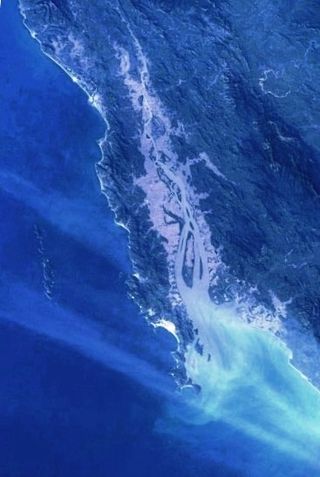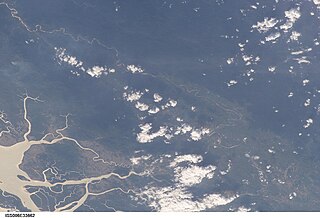
Dawei is a city in south-eastern Myanmar and is the capital of the Tanintharyi Region, formerly known as the Tenasserim Division, on the northern bank of the Dawei River. The city is about 614.3 km (381.7 mi) southeast of Yangon. Its population is 146,964. Dawei is a port at the head of the Dawei River estuary, 30 km (18.6 mi). from the Andaman Sea. As a result, the city is prone to flooding during the monsoon season. "Dawei" is also the name of one of Myanmar's 135 ethnic minorities.

Alaungpaya was the founder and first emperor of the Konbaung Dynasty of Burma (Myanmar). By the time of his death from illness during his campaign in Siam, this former chief of a small village in Upper Burma had unified Burma, subdued Manipur, conquered Lan Na and launched successful attacks against the French and British East India companies who had given help to the Restored Hanthawaddy Kingdom. He added settlements around Dagon, and called the enlarged town Yangon.

The Mergui Archipelago is located in far southern Myanmar (Burma) and is part of the Tanintharyi Region. It consists of more than 800 islands, varying in size from very small to hundreds of square kilometres, all lying in the Andaman Sea off the western shore of the Malay Peninsula near its landward (northern) end where it joins the rest of Indochina. They are occasionally referred to as the Pashu Islands because the Malay inhabitants are locally called Pashu.

Myeik is a rural city in Tanintharyi Region, Myanmar, located in the extreme south of the country on the coast off an island on the Andaman Sea. As of 2010, the estimated population was over 209,000. Myeik is the largest city in Tanintharyi Region, and serves as the regional headquarters of Myanmar Navy's Tanintharyi Regional Command. The area inland from the city is a major smuggling corridor into Thailand. The Singkhon Pass, also known as the Maw-daung Pass, has an international cross-border checkpoint.

Tanintharyi Region is a region of Myanmar, covering the long narrow southern part of the country on the northern Malay Peninsula, reaching to the Kra Isthmus. It borders the Andaman Sea to the west and the Tenasserim Hills, beyond which lie Thailand, to the east. To the north is the Mon State. There are many islands off the coast, the large Mergui Archipelago in the southern and central coastal areas and the smaller Moscos Islands off the northern shores. The capital of the division is Dawei (Tavoy). Other important cities include Myeik (Mergui) and Kawthaung. The division covers an area of 43,344.9 square kilometres (16,735.6 sq mi), and had a population of 1,406,434 at the 2014 Census.

The Myanmar Port Authority is a government agency vested with the responsibility to regulate and administer the coastal ports of Myanmar. It is a department of the Ministry of Transport. The MPA was founded in 1989 and is located in Yangon.

The Tenasserim Hills or Tenasserim Range is the geographical name of a roughly 1,700 km long mountain chain, part of the Indo-Malayan mountain system in Southeast Asia.

Thado Minsaw, also known as Shwedaung Min (ရွှေတောင်မင်း), was heir-apparent of Burma from 1783 to 1808, during the reign of his father King Bodawpaya of Konbaung dynasty. As Prince of Shwedaung and Dabayin, he was entrusted by the king to manage the day-to-day affairs of the kingdom, and when necessary, to lead the Royal Army against enemies. Thado Minsaw is best known for his conquest of Arakan in 1784–1785 and the subsequent removal of Mahamuni Buddha from Mrauk-U to Amarapura. He also led the successful defense of Tenasserim (Taninthayi) coast in 1792 in the war with Siam. The crown prince also led the revitalization of Burmese theater in the late 18th century by bringing a group of young artists to his court.

The Dawei River or Tavoy River is a river of the Tanintharyi Region, Burma.

The Great Tenasserim River or the Tanintharyi River is a major river of southeastern Burma. It flows through the Tanintharyi Region, past the town of Tanintharyi, and enters the sea at Myeik (Mergui). The river rises from the Tenasserim Range at an altitude of 2,074 m (6,804 ft), and flows into the Andaman Sea. The region formed by this river is also known as Tenasserim, or Tanintharyi in Burmese. It is in a constricted coastal region in southeastern Myanmar, which borders Thailand on the east and the Andaman Sea on the west.

The Burmese–Siamese War (1547–1549), also known as the Shwehti war was the first war fought between the Toungoo dynasty of Burma and the Ayutthaya Kingdom of Siam, and the first of the Burmese–Siamese wars that would continue until the middle of the 19th century. The war is notable for the introduction of early modern warfare to the region. It is also notable in Thai history for the death in battle of Siamese Queen Suriyothai on her war elephant; the conflict is often referred to in Thailand as the War that Led to the Loss of Queen Suriyothai (สงครามคราวเสียสมเด็จพระสุริโยไท).

Kanmaw Kyun or Kanmaw Island is an island in the Andaman Sea along the coast of southeastern Burma (Myanmar), and is part of the Mergui Archipelago. Administratively, it is located in Kyunsu Township, Myeik District, in the Taninthayi Region. On the northeastern side of the island is the town of Kyunsu, which is the administrative seat for the township. The island covers a total area of 409 km2.

The Burmese–Siamese War (1759–1760) or Alaungpaya's War was the military conflict between the Konbaung dynasty of Burma (Myanmar) and the Ban Phlu Luang Dynasty of the Ayutthaya Kingdom of Siam, in which the Burmese forces under King Alaungpaya of the Konbaung dynasty invaded Siam. After about a century of relative hiatus of Burmese–Siamese conflicts, this war reignited the new round of military conflicts between Burma and Siam that would last for about a century to come.

The Burmese–Siamese War also known as the War of the second fall was the second military conflict between Burma under Konbaung dynasty and Ayutthaya Kingdom under Siamese Ban Phlu Luang dynasty that lasted from 1765 until 1767, and the war that ended the 417-year-old Ayutthaya Kingdom.
The Myeik dialect, also known as Beik in Burmese, Mergui and Merguese in English, and Marit (มะริด) in Thai, is a divergent dialect of Burmese, spoken in Myeik, the second largest town in Tanintharyi Region, the southernmost region of Myanmar. Myeik shares many commonalities with the Tavoyan dialect, although there are substantial differences especially with regard to phonology.
Phu Nam Ron is a pass across the Tenasserim Hills on the border between Thailand and Myanmar, at an elevation of 350 metres (1,150 ft). The border checkpoint on the Thai side is in Ban Kao Subdistrict, Mueang Kanchanaburi District, Kanchanaburi Province.
Sinbyudaing, is a small village of Dawei District in the Taninthayi Region of Myanmar. It is located on the western side of the Tenasserim Range near the border with Thailand.

The Anglo-Siamese War was a brief state of war that existed between the English East India Company and Kingdom of Siam in 1687–88. Siam officially declared war against the Company in August 1687. No peace treaty was ever signed to end the war, but the Siamese revolution of 1688 rendered the issue moot.

The Burmese–Siamese War (1792–1794) or the Siamese Invasion of Tavoy was the conflict between the Kingdom of Burma under Konbaung dynasty and the Kingdom of Siam under the Chakri dynasty over the town of Tavoy and the Tenasserim Coast.

The Tavoy campaign of 1788 was a conflict between the Kingdom of Burma under Konbaung dynasty and the Kingdom of Siam under the Chakri dynasty over the town of Tavoy and the Tenasserim Coast.




















